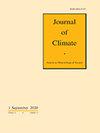新疆夏季复合高温干旱事件的年际变化及其与北大西洋海面温度的关系
IF 4
2区 地球科学
Q1 METEOROLOGY & ATMOSPHERIC SCIENCES
引用次数: 0
摘要
摘要 在全球变暖的情况下,新疆出现了复合高温干旱事件。然而,人们对该地区复合高温干旱事件变异的物理机制关注较少。本文研究了新疆夏季(6-7-8 月)复合高温干旱事件的年际变化及其与北大西洋海面温度(SST)的关系。结果表明,其第一个经验正交函数(EOF)模式具有空间同质模式的特征。该模式与北大西洋上空同时出现的经向负-正-负 SST 异常密切相关。夏季北大西洋三极海温异常会引发一列从北大西洋延伸到欧亚大陆的显著波列,从而在伊朗-帕米尔高原上空诱发异常高压系统,有利于新疆上空从地表到对流层上部的气温上升。对流层变暖进一步加强了西亚副热带经向温度梯度,从而增强了西亚副热带西风射流(WASWJ)北侧的西风。因此,西亚副热带西风射流向北移动,加剧了下沉运动,阻碍了水汽向新疆的输送,导致目标区域降水减少。气温升高和降水减少导致新疆上空出现复合高温干旱事件。基于共同体大气模式第 4 版(CAM4)的数值模拟进一步证实了新疆夏季北大西洋三极海温异常与复合高温干旱事件在年际尺度上的关系。本文章由计算机程序翻译,如有差异,请以英文原文为准。
Interannual variation of summer compound hot and drought events in Xinjiang and its relationship with the North Atlantic sea surface temperature
Abstract Xinjiang suffers compound hot and drought events under global warming. However, less attention has been paid to physical mechanisms of the variability of compound hot and drought events in this region. This article investigates the interannual variation of summer (June–July–August) compound hot and drought events in Xinjiang and its relationship with the sea surface temperature (SST) over the North Atlantic. The results show that its first Empirical Orthogonal Function (EOF) mode features a spatially homogenous pattern. This mode is closely connected with the simultaneous meridional negative–positive–negative SST anomalies over the North Atlantic. The summer North Atlantic tripole SST anomalies can trigger a remarkable wave train extending from the North Atlantic to Eurasia, consequently inducing an anomalous high-pressure system over the Iran–Pamirs Plateau, which is conducive to the increase of air temperature from the surface to the upper troposphere over Xinjiang. The warmer troposphere further strengthens the western Asian subtropical meridional temperature gradient and thereby enhances the westerly wind to the north flank of the West Asian subtropical westerly jet (WASWJ). As a result, the WASWJ is displaced northward, which intensifies the sinking motion and prevents the water vapor transport to Xinjiang, leading to a decrease of precipitation in the target region. The higher temperature and less precipitation contribute to the occurrence of compound hot and drought events over Xinjiang. Numerical simulations based on the Community Atmospheric Model version 4 (CAM4) further confirm the relationship between the North Atlantic tripole SST anomalies and compound hot and drought events in Xinjiang during summer on the interannual time scale.
求助全文
通过发布文献求助,成功后即可免费获取论文全文。
去求助
来源期刊

Journal of Climate
地学-气象与大气科学
CiteScore
9.30
自引率
14.30%
发文量
490
审稿时长
7.5 months
期刊介绍:
The Journal of Climate (JCLI) (ISSN: 0894-8755; eISSN: 1520-0442) publishes research that advances basic understanding of the dynamics and physics of the climate system on large spatial scales, including variability of the atmosphere, oceans, land surface, and cryosphere; past, present, and projected future changes in the climate system; and climate simulation and prediction.
 求助内容:
求助内容: 应助结果提醒方式:
应助结果提醒方式:


